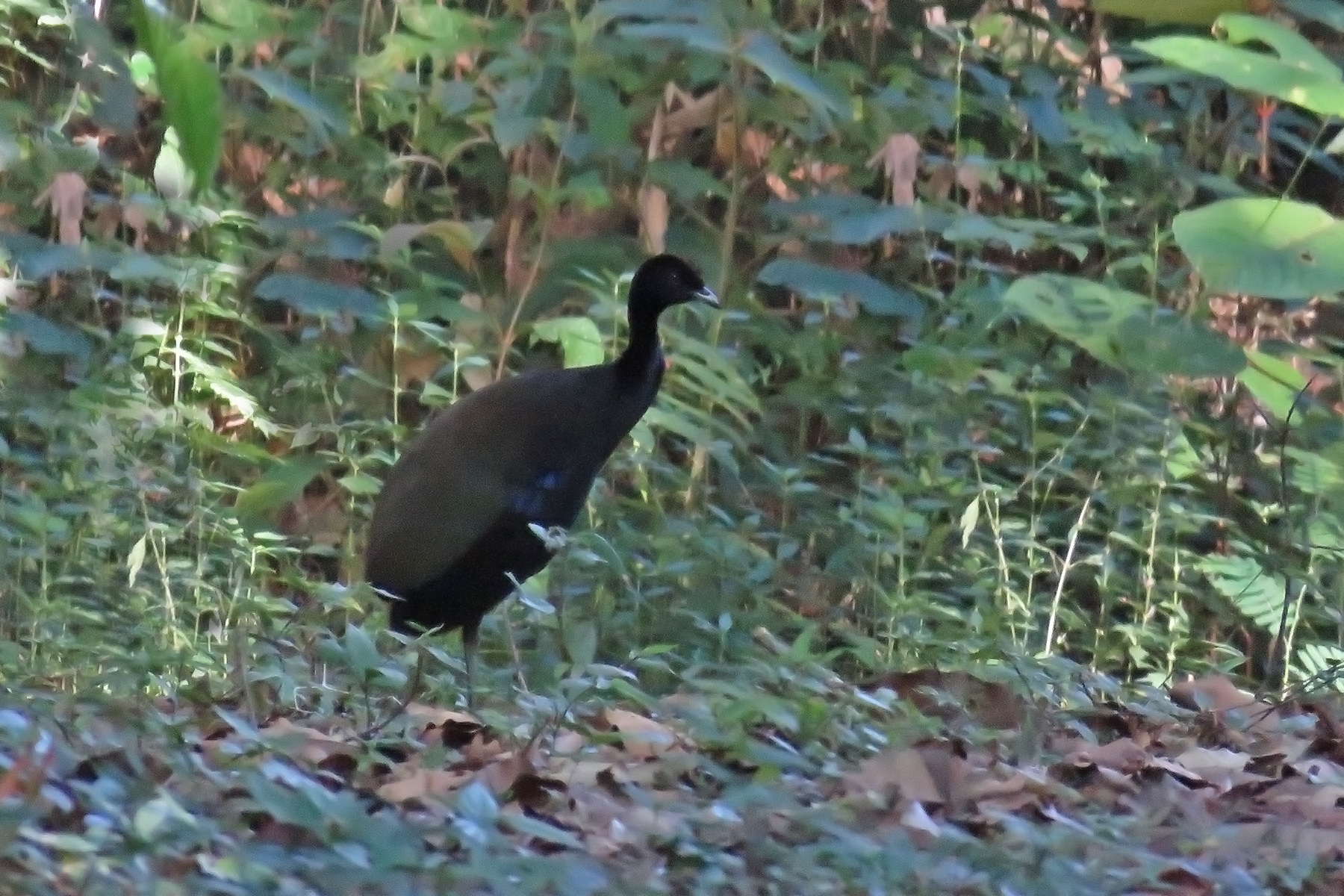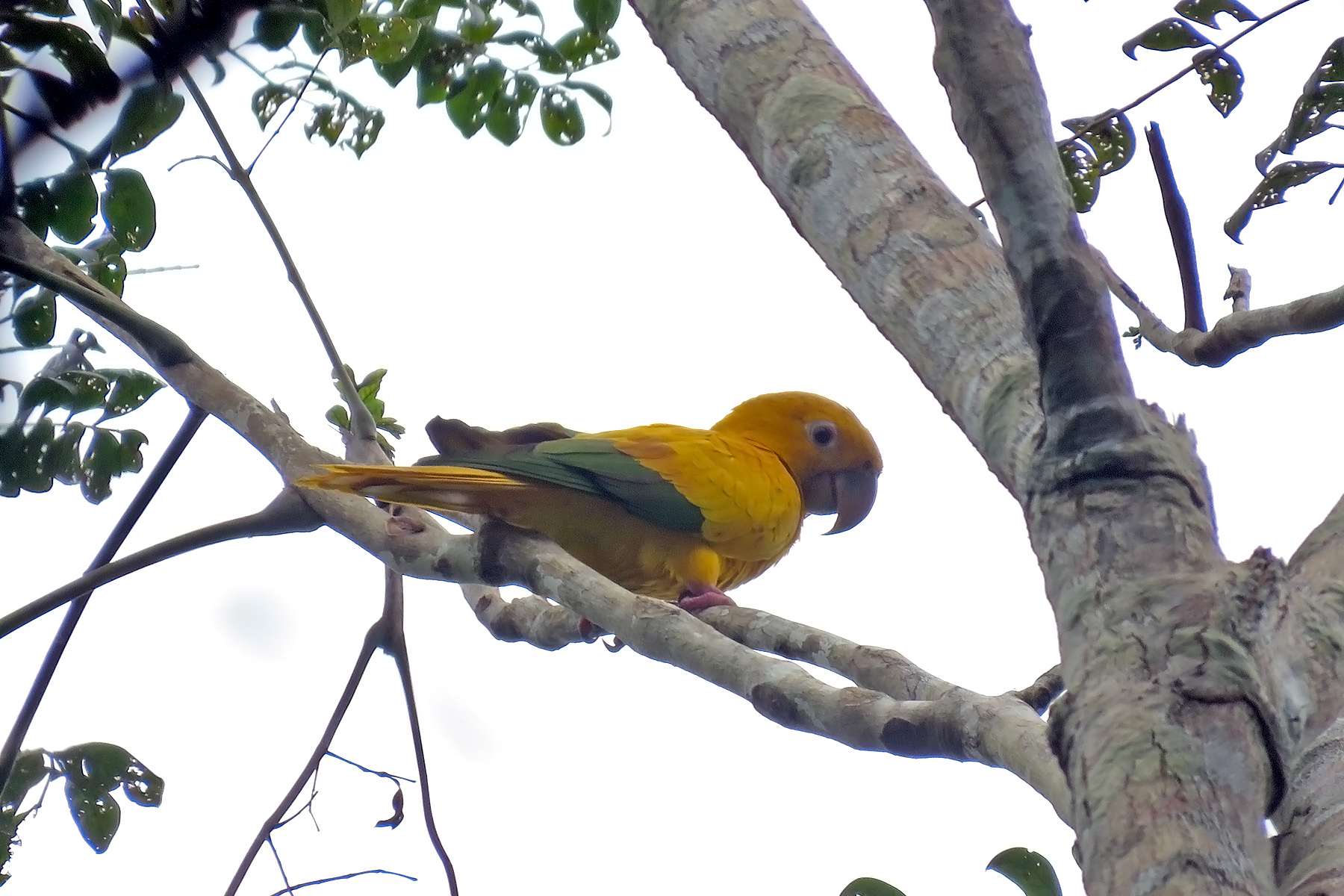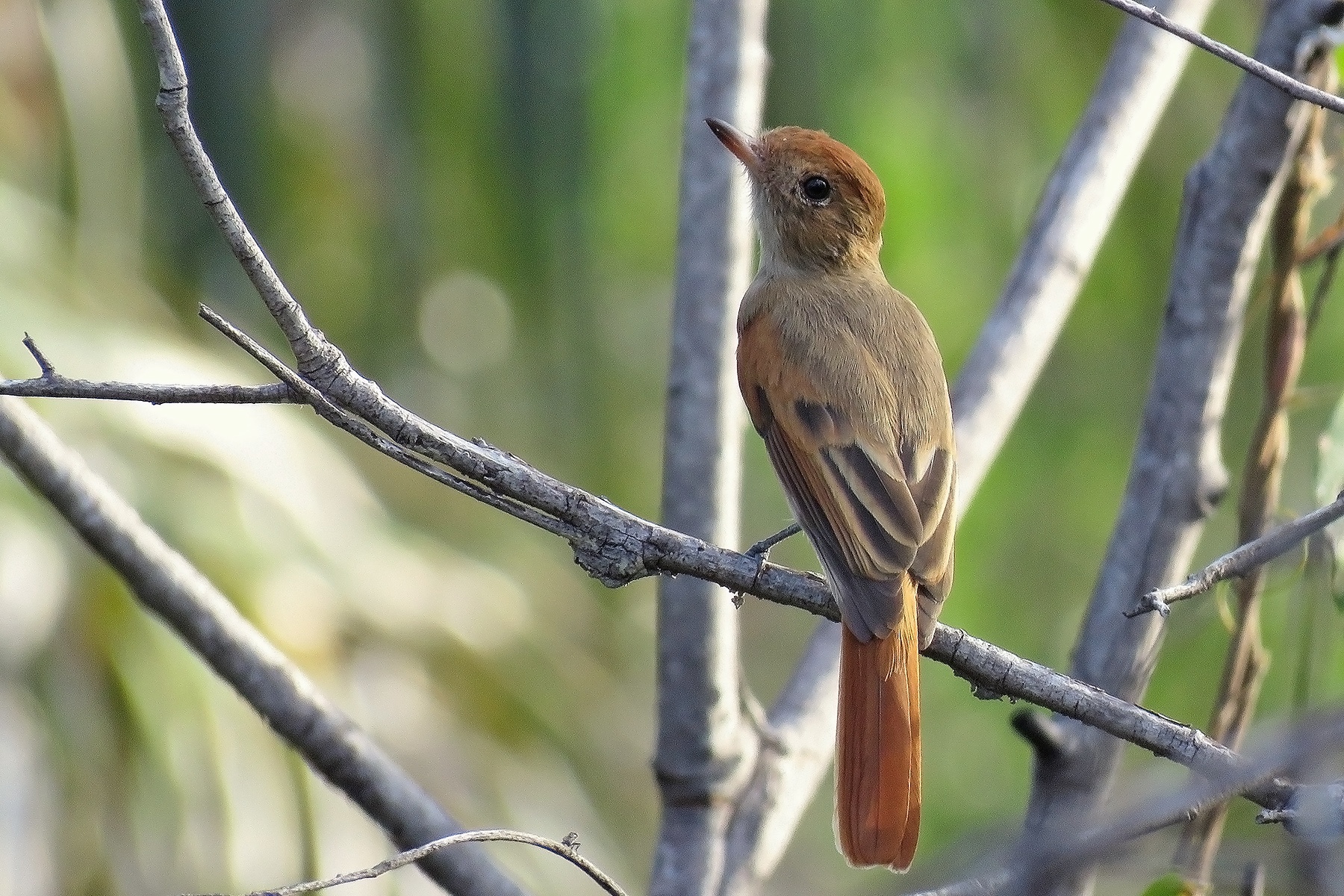BRAZIL’S EASTERN AMAZONIA BIRDING TOUR: DETAILED ITINERARY
Brazil’s Eastern Amazonia: Day 1 Our tour begins this afternoon at Belém, the capital of Pará state situated at the mouth of the mighty Amazon, where we will stay for two nights.
We will enjoy a little birding in the grounds of our hotel this afternoon. Normally there are large numbers of near-endemic White-winged Parakeets feeding in the palms. This fairly restricted-range species occurs mainly along the Amazon and Solimões Rivers. We should also see the endemic Buff-browed Chachalaca.
Widespread species include Black Vulture, Ruddy Ground Dove, Smooth-billed Ani, Short-tailed and Neotropical Palm Swifts, Yellow-bellied Elaenia, Spotted Tody-Flycatcher, Rusty-margined, Short-crested and Sulphury Flycatchers, Great Kiskadee, Tropical Kingbird, House Wren, Shiny Cowbird, Silver-beaked, Blue-grey and Palm Tanagers, and Bananaquit.
Brazil’s Eastern Amazonia: Day 2 We will spend our time in the Belém area birding at two different sites.
The forest of the Menino Jesus community in the municipality of Acará is about half an hour’s drive from our hotel. At Menino Jesus, a major target species is the handsome, restricted-range Black-chested Tyrant. Happily, we have excellent chances of seeing this beauty, which can also be found at Carajás.
The area offers some other great birds, including the lovely, near-endemic Red-necked Aracari (of the form bitorquatus), White-bellied Parrot, the endemic Dusky-capped Woodcreeper (the form layardi found here is sometimes split as Layard’s Woodcreeper), Amazonian Barred Woodcreeper, the near-endemic Willis’s Antbird, Spot-winged Antshrike, Purple-throated Fruitcrow, Pink-throated Becard, Green Oropendola and Olive Oropendola (of the form bifasciatus). Pale-throated Barbthroat, Fiery-tailed Awlbill and Cinnamon-rumped Foliage-gleaner are uncommon but possible here.
As we cover a stretch of floodable (varzea) forest we should expect to find such species as Cream-colored Woodpecker, Striped Woodcreeper and Band-tailed Manakin and possibly Silvered Antbird and Grey-headed Tanager.
We will also explore the Gunma Ecological Park in the neighbouring town of Santa Barbara do Pará. This nice tract of forest is also only half an hour’s drive from our hotel and offers our first chance for the uncommon endemic Opal-crowned Manakin and endemic East Amazonian Fire-eye.
The bird list from these two areas is long and we should expect to record plenty of species. Likely species include Little Tinamou, Western Cattle and Great Egrets, Turkey and Greater Yellow-headed Vultures, Double-toothed Kite, Savanna, Roadside and Grey-lined Hawks, Southern Lapwing, Pale-vented and Ruddy Pigeons, Guira and Squirrel Cuckoos, Burrowing Owl, Lesser Swallow-tailed Swift, Reddish Hermit, Grey-breasted Sabrewing, Black-throated Mango, Fork-tailed Woodnymph, Black-eared Fairy, Black-tailed, Green-backed, Amazonian and Black-throated Trogons, Amazonian Motmot, White-fronted Nunbird, Lettered Aracari, White-throated Toucan, Lineated and Red-necked Woodpeckers, Red-throated and Yellow-headed Caracaras, Golden-winged Parakeet and Orange-winged Amazon.
Passerines include Plain-crowned Spinetail, Plain Xenops, Wedge-billed and Amazonian Barred Woodcreepers, Chestnut-backed and White-shouldered Antshrikes, White-flanked, Grey, Southern White-fringed and Rufous-winged Antwrens, Xingu Scale-backed and Grey Antbirds, Black-spotted Bare-eye, Yellow-headed, White-lored and Southern Beardless Tyrannulets, Helmeted Pygmy Tyrant, Slaty-headed and Yellow-browed Tody-Flycatchers, Ochre-bellied, Dusky-chested and Dusky-capped Flycatchers, Grey-crowned and Ochre-lored Flatbills, Screaming Piha, Dwarf Tyrant-Manakin, White-bearded Manakin, White-browed Purpletuft, the near-endemic Grey-chested Greenlet, White-winged Swallow, Grey-breasted Martin, Moustached Wren, Long-billed Gnatwren, Tropical Gnatcatcher, White-lored Euphonia, Pectoral Sparrow, Yellow-rumped Cacique, Yellow-green Grosbeak, Bay-headed, Turquoise and Flame-crested Tanagers, Blue Dacnis, Purple Honeycreeper and Buff-throated Saltator.
More uncommon species include Hook-billed Kite, Russet-crowned Crake, Little Cuckoo, Long-tailed Hermit, Racket-tailed Coquette, Blue-chinned Sapphire, McConnell’s Flycatcher, White-crowned Manakin and Golden-sided Euphonia.
Mammals are inconspicuous but may include Black-handed Tamarin.
Brazil’s Eastern Amazonia: Day 3 After some final birding around Belém, we will take a flight westwards to Itaituba, situated in Pará state on the west bank of the large and beautiful dark-water Tapajós River.
From Itaituba the dirt road drive takes a little more than an hour to reach the vast and impressive Amazonia (or Tapajós) National Park, which is cut by the BR-230 (Transamazônica Highway). Our rustic-style lodge, where we will stay for five nights, is situated in a clearing right at the banks of the Tapajos’ and the border with the national park. Views of the river are quite amazing with exposed rocks and islands right in front. Perhaps we will arrive just in time for sunset.
Brazil’s Eastern Amazonia: Days 4-7 During our extended stay in the huge Amazonia (or Tapajós) National Park we will be looking for a fantastic array of birds.
The lodge’s garden always holds a variety of birds (mostly common species but eventually something more unexpected) as it is positioned by the riverbank and surrounded by forest fragments.
Here we should expect to record species such as Large-billed and Yellow-billed Terns, Swallow-winged Puffbird, Black-fronted Nunbird, Black Caracara, Red-bellied Macaw, Santarem Parakeet, Long-billed Woodcreeper, Southern Rough-winged, White-banded and Black-collared Swallows, Yellow-browed Sparrow and Chestnut-bellied Seedeater.
During our visits to the park, we will be covering at least five different trails (Tracoá, Piçarreira, Açaizal, Capelinha and Uruá), plus the roadsides and parts of the river (sandbanks and islands). Good terra firme forest is the most easily accessible and interesting major habitat in the park. We will also cover some floodable igapó forest next to the banks of the Tapajós, the river itself (including forested islands, sandbanks, rapids, etc) and a few marshes. We will arrange at least one boat trip targeting some riverine specialities, visiting some river islands next to our lodge and even visiting the east bank of Tapajos if conditions allow. We will also take an afternoon to visit a quite distant marsh which normally serves as a roosting site for the localized endemic Golden Parakeet.
Birding will be quite intense as we concentrate our efforts on the fascinating local specialities and many other great birds.
These include such endemics and near-endemics as White-crested Guan, Red-throated Piping-Guan, Dark-winged Trumpeter (of the nominate form viridis), Blue-necked Jacamar, the very restricted-range Brown-chested Barbet, the awesome Golden Parakeet, Crimson-bellied Parakeet, the strange Vulturine Parrot, Hoffmann’s Woodcreeper, Dusky-capped Woodcreeper (of the nominate form, known as Rondonia Woodcreeper), Glossy Antshrike, Rufous-faced Antbird, the amazing Black-bellied Gnateater and the beautiful White-tailed Cotinga. With both persistence and luck, we should also find a number of the following: the fantastic Crimson Topaz, Kawall’s Amazon, Pale-faced Bare-eye, Tapajos Hermit and Tapajos and Alta Floresta Antpittas.
Other good birds include White-browed Hawk, Sand-colored Nighthawk, Spotted and Collared Puffbirds, Elegant Woodcreeper, the nominate form of the Dusky-capped Woodcreeper (known as Rondonia Woodcreeper), Dot-winged, Ihering’s, Sclater’s and Ash-winged Antwrens, Saturnine and Blackish-grey Antshrikes, Band-tailed, Ferruginous-backed and Banded Antbirds, the localized Harlequin Antbird, the amazing Rusty-belted Tapaculo, Snow-capped Manakin, Zimmer’s (Sucunduri) Flatbill, Amazonian Inezia, Golden-crowned Spadebill, Cinereous Mourner, Cinereous Becard and Buff-cheeked Greenlet. More uncommon possibilities include Razor-billed Curassow, Fiery-tailed Awlbill, Zimmer’s Woodcreeper, Speckled Spinetail, Slender-billed Xenops and Flame-crested Manakin.
A boat trip will take us to the east bank of Tapajós. On this side of the river, we will be hoping to find some special targets that occur in the area between the Tapajós and Xingu Rivers such as Black-girdled Barbet and Bare-eyed Antbird. We can always hope to encounter the rare, enigmatic and threatened endemic Golden-crowned Manakin, but this is a very rare bird.
Besides these species, there are of course numerous additional species that we have chances to record during our stay!
The most likely candidates include Cinereous, Undulated and Variegated Tinamous, Speckled Chachalaca, Horned Screamer, Green Ibis, Snowy Egret, Neotropic Cormorant, Anhinga, Black and Ornate Hawk-Eagles, Plumbeous Kite, Great Black and Short-tailed Hawks, Wattled Jacana, Plumbeous Pigeon, White-tipped and Grey-fronted Doves, Common Ground Dove, Greater Ani, Amazonian Pygmy Owl, Common Potoo, Pauraque, Band-rumped Swift, Black-eared Fairy, Green, Amazon and Ringed Kingfishers, Amazonian, Rufous and Broad-billed Motmots, Green-tailed and Paradise Jacamars, White-necked Puffbird, Black-necked Aracari, Gould’s Toucanet, Channel-billed Toucan, Bar-breasted Toucanet, Yellow-tufted, Red-stained, Yellow-throated, Chestnut and Crimson-crested Woodpeckers, Laughing and Bat Falcons, Scarlet and Chestnut-fronted Macaws, Blue-headed and Red-fan Parrots, Yellow-crowned and Southern Mealy Amazons, and White-eyed Parakeet.
Among the passerines: Buff-throated Foliage-gleaner, Plain-brown, Long-tailed, Olivaceous, Long-billed, Straight-billed, Elegant and Buff-throated Woodcreepers, Natterer’s Slaty Antshrike, Cinereous, Amazonian, Plain-winged and Fasciated Antshrikes, White-eyed Stipplethroat, Amazonian Streaked and Plain-throated Antwrens, Blackish, Black-faced and Spix’s Warbling Antbirds, Amazonian Antpitta, Forest Elaenia, Short-tailed Pygmy Tyrant, White-crested Spadebill, Rufous-tailed Flatbill, Amazonian Royal Flycatcher, Dusky-chested, Variegated and Three-striped Flycatchers, Greyish Mourner, Ci9nnamon Attila, Spangled Cotinga, Bare-necked Fruitcrow, Red-headed Manakin, Brown-winged Schiffornis, Crested Becard, Chivi Vireo, Buff-cheeked and Tawny-crowned Greenlets, Brown-chested Martin, Thrush-like Wren, Red-capped Cardinal, Red-billed Pied, Fulvous-crested, Paradise and Opal-rumped Tanagers, Black-faced Dacnis and Green Honeycreeper.
More uncommon species include Grey and White-throated Tinamous, Capped Heron, Muscovy Duck, Harpy and Crested Eagles, Grey-breasted Crake, Grey-cowled Wood Rail, Purple Gallinule, Pied Plover, Black Skimmer, Black-bellied Cuckoo, Tropical Screech Owl, Crested Owl, Great-billed and Streak-throated Hermits, Pavonine Quetzal, Blue-crowned Trogon, Green-and-rufous and American Pygmy Kingfishers, Bromzy and Great Jacamars, Chestnut-capped Puffbird, Rusty-breasted Nunlet, Scaly-breasted Woodpecker, Collared and Barred Forest Falcons, Ruddy Spinetail, White-chinned and Spot-throated Woodcreepers, Zimmer’s Tody-Tyrant, Whiskered Myiobius, White-thighed Swallow and Red-crowned Ant Tanager.
As always in Amazonia, mammals are inconspicuous but may well include White-fronted and Guianan Brown Capuchins and also the strange-lookinbg Red-nosed Bearded Saki.
Brazil’s Eastern Amazonia: Day 8 After spending much of the day birding at Amazonia National Park, we will return to Itaituba for an overnight stay.
Brazil’s Eastern Amazonia: Day 9 Today we will drive northwards to the city of Santarém, situated at the junction of the Tapajós River with the mighty Amazon. From here we will cross the river by ferry and make our way to the town of Monte Alegre for a two nights stay.
Brazil’s Eastern Amazonia: Day 10 We will be concentrating our efforts on the North (or Left) Bank of the Amazon on finding the beautiful, endemic and only relatively recently-described Sulphur-breasted Parakeet. This is surely one of the most beautiful psittacids in the entire country, and that is saying a lot!
We are also sure to encounter some species of wider distribution that have the Amazon as the southern limit of their distribution.
Brazil’s Eastern Amazonia: Day 11 Today we will return to Santarém and catch a flight back to Belém where we connect with a flight to Carajás (Parauapebas) airport in the southeastern part of the state of Pará. From there we will drive to the nearby town of Parauapebas for a six nights stay at the comfortable Hotel Vale dos Carajás.
Brazil’s Eastern Amazonia: Days 12-17 We will definitely enjoy birding the amazing hills and valleys of Carajás National Forest. Holding the largest iron ore reserves on the planet, the Carajás National Forest is run by Vale, the major mining company in Brazil and one of the biggest in the world. The iron outcrops are located on the top of the hills, creating a peculiar stunted and dry habitat called ‘canga’, where some Cerrado specialists and other open country bird species share the same area. The tall forests of the plateaus, foothills and valleys of Carajás comprise a mega-diverse part of Amazonia where huge and imposing Brazil Nut Trees decorate the vast landscape.
We will have time to visit a series of different areas and habitats during our extended stay.
A prime site to visit is a fascinating area known as Aguas Claras, where tall terra firme with plenty of Brazil nut trees creates a beautiful and inviting forest. The road offers very good birding, but we will also want to reach the Aguas Claras stream by following a nice trail. Along this trail, we will be targeting the stunning, restricted-range Guianan Red Cotinga in the mid-levels of the forest, as well as other forest interior species. We will also be hoping for an active Harpy Eagle nest in this fine area, which gives us our best chance during the tour for this most-wanted species. We may well also find such Brazilian endemics and near-endemics as Cryptic Forest Falcon, Rufous-throated Sapphire (and with luck Dot-eared Coquette), Eastern Striolated Puffbird, the wonderful Hyacinth Macaw, Para Foliage-gleaner, Brigida’s Woodcreeper, Rufous-faced Antbird and Opal-crowned Manakin. This is a good area for the restricted-range and very patchily distributed Blackish Pewee and also the lovely Purple-breasted Cotinga. Our lunch will most likely be enjoyed by the Aguas Claras stream with a lovely opportunity for a freshwater bath to cool off! By staying until dark, we have a good chance for the restricted-range Silky-tailed Nightjar.
Another excellent area is the Lagoa da Mata trail, an easy and flat trail in tall terra firme forest in the hills. The near-endemic Brazilian Tinamou is regular here and with luck we will see one as well as hearing them. Among many other great birds in this area are the impressive, near-endemic Bare-faced Curassow and the beautiful Chestnut-belted Gnateater and the uncommon Wing-banded Antbird. The lake in the forest, which usually holds only a little water during our visits, has a nice boardwalk from where you can see some interesting species. We will also cover some second growth and forest-edge habitat, mainly in search of Wing-barred Seedeater and Marbled Wood Quail.
At a lower altitude, just beside the town of Parauapebas, we can follow a good track that passes through a lovely stretch of lowland terra firme forest and eventually reaches the bank of the Parauapebas River. This area is good for the endemic Snethlage’s Antpitta and the near-endemic Rusty-margined Guan and Snethlage’s Tody-Tyrant.
We will also want to spend time in the fantastic foothill area of Pojuca. We will drive about an hour and a quarter to reach this amazing forest which is rich in bamboo. Two main tracks offer excellent birding including a number of bamboo specialists, some endemics and near-endemics and some scarce or rare species. Major endemic and near-endemic targets include the endemic White-crested Guan, Rufous-capped Nunlet, the superb and only relatively recently rediscovered Kaempfer’s Woodpecker, Pearly Parakeet, the strange Peruvian Recurvebill and Manu Antbird, as well as the restricted-range Chestnut-throated Spinetail and Black-and-white Tody-Flycatcher. In addition, the near-endemic Dark-winged Trumpeters here are of the form dextralis, a potential split as Brown-winged Trumpeter (the nominate form, found at Amazonia National Park, has green wings). One visit to this marvellous area will barely be enough, so we are almost sure to return!
We will also explore some fascinating hilly forest that includes a known site for the splendid and loud White Bellbird. We should be able to enjoy extended views of this marvellous bird. In the same area, we will spend some time in the forest in search of targets such as the uncommon Waved Woodpecker and the tricky, near-endemic Rufous-necked Puffbird.
Outside the National Forest’s gate near Pojuca, we will cover some open roadside habitats such as marshes, second growth, palm groves and forest edge which should provide a bunch of nice birds that are hard or impossible inside the reserve, including the uncommon Rufous-sided Crake.
In the peculiar ‘canga’ (savanna-like) habitat at the site called N2 we should see a new array of birds in this characteristic open bushy habitat, including such species as Small-billed Tinamou, Russet-crowned Crake, the stunning endemic Jandaya Parakeet, Sooty-fronted and Pale-breasted Spinetails, Plain-crested and Lesser Elaenias, Pearly-vented Tody-Tyrant, Brown-crested Flycatcher, the endemic White-naped Jay and the lovely but uncommon Black-faced Tanager.
In the nearby transitional forest, we will be searching for the tricky Pheasant Cuckoo, the endemic Ash-throated Casiornis and the stunning endemic White-tailed Cotinga, as well as the smart Ochre-cheeked Spinetail, the uncommon Zimmer’s Tody-Tyrant, Pale-bellied Tyrant-Manakin, Blue-backed Manakin and Golden-crowned and Flavescent Warblers. We will also be alert for Scarlet-shouldered Parrotlet and Pale-bellied Mourner; both are interesting species that occasionally show up in this area. We will also cover some pretty good terra firme forest situated only a few hundred metres from the interesting ‘canga’ habitat of N2. Roadsides and short narrow trails in the forest will offer chances for a good variety of birds and we can expect some large canopy mixed flocks.
We will also visit a stakeout near the Carajás mine for the endemic Chestnut-headed Chachalaca.
Among the numerous additional species we may well encounter at Carajás are Least Grebe, Wood Stork, Cocoi Heron, King Vulture, Swallow-tailed Kite, White-tailed and White Hawks, Hoatzin, Scaled Pigeon, Blue Ground Dove, Blackish Nightjar, Pale-rumped Swift, White-necked Jacobin, Versicolored Emerald, Long-billed Starthroat, Rufous-tailed Jacamar, Pied Puffbird, White-throated and Green-barred Woodpeckers, and Red-and-green Macaw.
Passerines include Cinnamon-throated, Strong-billed and Spix’s Woodcreepers, Point-tailed Palmcreeper, Rufous-tailed, Rufous-rumped and Chestnut-crowned Foliage-gleaners, Plain Xenops, Ornate Stipplethroat, Pygmy Antwren, Great Antshrike, White-browed Antbird, Black-faced and Rufous-capped Antthrushes, Wing-barred Pipirites, Grey Elaenia, Guianan Tyrannulet, Slaty-headed Tody-Flycatcher, Yellow-olive Flatbill, Amazonian Scrub, Cliff, Piratic, Streaked, Boat-billed and Ruddy-tailed Flycatchers, Long-tailed Tyrant, Lesser Kiskadee, Black-tailed and Masked Tityras, Chestnut-crowned and Black-capped Becards, Rufous-browed Peppershrike, Slaty-capped Shrike-Vireo, Dusky-capped Greenlet, Black-capped Donacobius, Coraya and Buff-breasted Wrens, Pale-breasted Thrush, Purple-throated, Violaceous, Rufous-bellied and White-vented Euphonias, Red-breasted Blackbird, Epaulet Oriole, Giant Cowbird, the lovely Rose-breasted Chat, Rothschild’s and Slate-colored Grosbeaks, Magpie, White-shouldered, White-lined, Spotted, Masked, Guira and Swallow Tanagers, White-winged Shrike-Tanager, Chestnut-vented Conebill, Greyish Saltator, Blue-black Grassquit, Yellow-bellied and Chestnut-bellied Seedeaters, and Chestnut-bellied Seed Finch.
We will also encounter some of the less common (or at least harder-to-see) birds of the area, which include the near-endemic White-bellied Tody-Tyrant as well as the more widespread Rufescent Tiger Heron, Snail and Slender-billed Kites, Black-and-white Hawk-Eagle, Slaty-backed Forest Falcon, Limpkin, Scaled Dove, Pavonine Cuckoo, Tawny-bellied Screech Owl, Spectacled, Mottled and Black-banded Owls, Short-tailed Nighthawk, Ocellated Poorwill, Rufous Nightjar, Black-bellied Thorntail, Golden-green Woodpecker (of the form paraensis), Dusky-billed Parrotlet, Red-fan Parrot, Dusky Leaftosser, Black-banded Woodcreeper, Curve-billed Scythebill, Cinnamon-rumped Foliage-gleaner, Variegated Antpitta, Small-billed Elaenia, Cinnamon-crested Spadebill, Fiery-capped Manakin, Sharpbill, Amazonian Royal Flycatcher, Green-backed Becard, Southern Nightingale-Wren, Cocoa Thrush, Riverbank Warbler, Crested Oropendola, Red-rumped Cacique, Grassland Sparrow, Yellow-bellied Dacnis and Red-legged Honeycreeper.
In addition, there will be second chances for quite a number of the species mentioned for Belém and Amazonia National Park.
New mammals may include Red-handed Howler Monkey and Red-bellied Titi Monkey.
Brazil’s Eastern Amazonia: Day 17 This morning we will head for the Carajás airport, where our tour ends.







































































